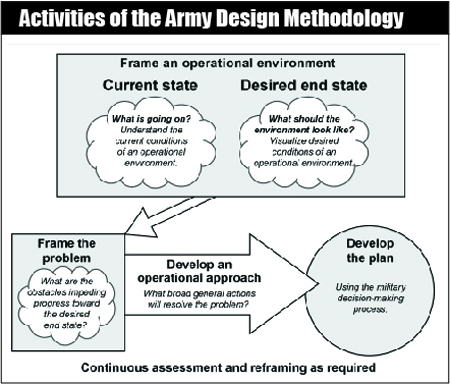Army design methodology (ADM) is a methodology for applying critical and creative thinking to understand, visualize, and describe problems and approaches to solving them (ADP 5-0). It entails framing an operational environment (OE), framing problems, and developing an operational approach to solve or manage identified problems. ADM results in an improved understanding of an OE, a problem statement, and an operational approach that serves as the link between conceptual and detailed planning.

During execution, assessment helps measure the effectiveness of operations and determine if the operational approach remains feasible and acceptable within the context of the higher echelon commander’s intent and concept of operations. If the current operational approach fails to meet these criteria, or if aspects of an OE change significantly, the commander may decide to reframe. Reframing involves revisiting earlier hypotheses, conclusions, and decisions that underpin the current operational approach. Reframing can lead to a new problem statement and operational approach, resulting in an entirely new planning effort.
ADM is an interdisciplinary approach to planning and problem solving. It combines military theory, writings on the nature of problems, and the challenges of critical and creative thinking. Some of these concepts, such as operational art, have long been associated with planning. Other concepts such as systems thinking and framing have taken on increased emphasis. Key concepts associated with ADM include—
Steps of Army Design Methodology
Army design methodology includes interconnected activities that aid in conceptual planning and the application of operational art. There is no one way or prescribed set of steps to employ Army design methodology. However, several activities associated with ADM include—
While planners can complete some activities before others, the understanding and learning in one activity may require revisiting previous learning. Thus, ADM is iterative in nature. Based on their understanding gained during ADM, commanders issue planning guidance—including an operational approach—to guide more detailed planning using the military decision-making process (MDMP).
Editor’s note: Army leaders employ several methodologies for planning, determining the appropriate mix based on the scope and understanding of the problem, time available, and availability of a staff. Army planning methodologies include the Army design methodology (ADM), military decision-making process (MDMP), troop leading procedures (TLP), rapid decision-making and synchronization process (RDSP), and Army problem solving. All five planning methodologies are discussed in The Battle Staff SMARTbook.
 This article is an extract from "BSS7: The Battle Staff SMARTbook, 7th Ed. (Planning & Conducting Multidomain Operations)" by The Lightning Press. Download a free PDF sample and learn more at: BSS7: The Battle Staff SMARTbook, 7th Ed. (Planning & Conducting Multidomain Operations).
This article is an extract from "BSS7: The Battle Staff SMARTbook, 7th Ed. (Planning & Conducting Multidomain Operations)" by The Lightning Press. Download a free PDF sample and learn more at: BSS7: The Battle Staff SMARTbook, 7th Ed. (Planning & Conducting Multidomain Operations).
Browse additional military doctrine articles in our SMARTnews Blog & Resource Center.
About The Lightning Press SMARTbooks. Recognized as a “whole of government” doctrinal reference standard by military, national security and government professionals around the world, SMARTbooks comprise a comprehensive professional library. SMARTbooks can be used as quick reference guides during operations, as study guides at education and professional development courses, and as lesson plans and checklists in support of training. Browse our collection of Military Reference SMARTbooks to learn more.













































